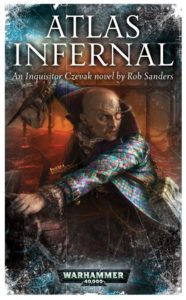This book is pure pulp (this is a compliment, one of my highest). Just look at these words.
The Path Incarnadine, a haemovore death cult that single handedly defended the Carfax Hive on the cardinal world of Aspiratyne from the predations of the dark eldar Fell Witch and her World-Scourgers.
Yes, it’s goofy. But they take place in a goofy world. Because, after all, Atlas Infernal is a Warhammer 40,000 novel, a novel that takes place in a grim future where there is only war. Where the forces of the undying God-Emperor fight ceasely against the forces of Ruinous Chaos. Where fearless, and more or less insane, Inquisitors enforce the Imperial theology against monsters such as
Gallkor-Teth the Decimate
Inquisitor Bronislaw Czevak is one such member of the Inquisition. Very old and very fierce in his pursuit of forbidden knowledge that he needs to fight the Chaos Lord Ahzek Ahriman. Forbidden knowledge that brings him perilously close to the edge of heresy and damnation. Forbidden knowledge that leads him to the Eldar (space elves. there are also space orks. like I said, pure pulp.) and their Black Library.
the Palatyne Sceptoclasm
In his quest, he’s aided by Interrogator Raimus Klute, a TechnoMarine, a blind warp-seer with her pet demon (another cute bit of the Warhammer 40K universe is that in order for a spaceship to travel faster than light, it has to go through Hell, quite literally. Warp space is a hell dimension and only a spaceship’s shields keep it from being destroyed by demons every time it goes FTL), and a group of Savlar Chem-Dogs, drugged out gun bunnies from a penal battalion.
the Flesh Mines of Marriar
It’s a quest story, in its bones. Czevak is searching for pieces of the Demon Lord Mammoshad before Ahriman finds them all, puts them together, and raises the demon lord to fight for Chaos. The group, on the spaceship Malescaythe, travel from planet to planet. They visit a hive city that’s fallen to the forces of Chaos and whose inhabitants have become feral cannibals. There’s an extensive shoot out as they’re discovered raiding the treasure vaults of a Space Marine chapter. Remember, this is still a Warhammer novel and so there’s a lot of shooty-shooty.
Umbragg of the Brazen Flesh and the Rage Lords of Taurm
There are several different kinds of Warhammer 40K novels. Most of them involve the very violent adventures of the Space Marines (genetically engineered giant humans with two hearts and really big armor. Only male Space Marines. The roots of Warhammer 40K lie in the 70s and the gender assumptions of that time and of the gaming industry of that time still are a part of this fictional universe.). Other novels are about various units of the Imperial Guards army, humans fighting in the war that never ends on the ground or in space. The ones that I like the most are those that involve the Inquisition. In those, especially the ones written by Dan Abnett about the Inquisitors Eisenhorn and Ravenor, the reader gets a more human view of Imperial civil society, a street level view of how regular people live, rather than huge ultra-violence of the Space Marines or the never ending battlefields and military life of the Guards.
the sinister shapes of a grimoire-diabolicus of True Names, a hexagrammic stamphammer, a stasis-casked astramoebic warp infestation
This is one of my favorite Warhammer novels. I really like the Gaunt’s Ghosts series as well as the Eisenhorn and Ravenor books, but the sheer baroque pulpiness that Rob Sanders has achieved in Atlas Infernal is very appealing. In the vast number of Warhammer novels, this one stands out.
The Seven Star Hegemony, the Vilo Rouge Twist Cleansings and the Decromunda Hive Holocaust
